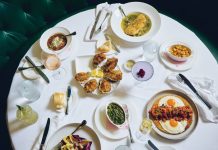
Have you ever tried to make a roux? It sounds easy. Just combine equal parts lard and flour over heat.
But it is not easy. I’ve been stirring twenty minutes, and it’s still not the rich, reddish-brown color it’s supposed to be. It’s also too thick, so I have to add oil. I keep stirring, and the mixture begins to turn several shades of tan, which means I’m moving too slowly. “Don’t stir,” says Ricardo Fredericks, my instructor at the New Orleans School of Cooking. “Push and pull.” And so I dredge the roux back and forth, hoping I can get this right and learn to make my husband’s favorite dish, gumbo.
 “There you go!” Fredericks says, grabbing my spoon and criss-crossing the roux with it. “I promise, this is the most fun you’ll have in this city with your clothes on.”
“There you go!” Fredericks says, grabbing my spoon and criss-crossing the roux with it. “I promise, this is the most fun you’ll have in this city with your clothes on.”
It is fun being in this nineteenth-century French Quarter warehouse, standing in front of a professional-grade stove and making a roux. It’s also intimidating. Roux is the building block for my recipe, the thing the separates the real Louisiana cooks from the pretenders. (The school’s adjoining store sells a book entitled Who’s Your Mama, Are You Catholic, and Can You Make a Roux?) I am admittedly a pretender, but I’d at least like to pretend in a way that results in something edible.

Photograph courtesy of the New Orleans School of Cooking
We’re making a Cajun version of gumbo, which means it traces its roots not to New Orleans, but to rural areas outside the city. During the nineteenth century, Cajun was to Creole what country was to city. Cajuns used lard in their recipes, while Creoles favored butter. Cajuns skipped hard-to-grow vegetables like tomatoes; Creoles incorporated them into their dishes. The most surefire way to show your ignorance about Louisiana cooking is to refer to Cajun cooking as “New Orleans style.” Well, that and pronouncing “pecans” wrong. (“Pee-cans are cans we use in the middle of the night and pitch out the window,” Fredericks says. “Peh-cahns, we eat.”)
It’s time to add “the trinity”—onions, celery, and green peppers—to my gumbo. Next, garlic, “the pope of flavor.” I stir them into my roux; their fragrances are as divine as their nicknames. By the time I throw in chicken and Andouille sausage, I’m starting to feel pretty good about what’s inside my little pot. I sprinkle dried sassafras leaves, called file (pronounced “fee-lay”), over the top, add some crab boil spice mix, and allow myself a taste.
Damn. My husband is lucky.
The rest of the evening, I cook up a feast of fish meuniere, maque choux, and pecan pralines. The fish is golden brown and rich, thanks to the “monter au beurre” (mount with butter) technique Fredericks teaches me as I finish the dish. The maque choux, a popular corn-based side dish, delivers a spicy jolt, and the warm pralines melt on my tongue. By the time I return to my room at the Pontchartrain Hotel, I am both very proud and very, very full.

Photograph by Allison Entrekin
By the next day, though, I’m hungry for more. I show up for Destination Kitchen‘s food tour of the French Quarter, which provides culinary inspiration to home cooks like me. Our guide, Lisa Smyth, has us sample everything from boudin balls at Kingfish to Creole beef brisket at Tujague’s to muffalettas at Alberto’s in the French Market. She tells us the ingredients in each dish, introduces us to the chefs, and reminds us that New Orleans is the only city in the country with its own cuisine. “When you learn to cook like we do, you share in our identity,” she says.
After the tour, I spend the afternoon browsing cookbooks at Kitchen Witch, ogling culinary antiques at Lucullus (where I fall in love with a rare nineteenth-century absinthe spoon holder), and checking out the massive Southern Food and Beverage Museum, complete with its own demo kitchen.
For dinner, I head to Brigtsen’s in Uptown, where Chef Frank Brigtsen has cooked classic Creole dishes for the last thirty-one years. Brigtsen trained under legendary New Orleans chef Paul Prudhomme, and he’s known as a torchbearer for the city’s traditional recipes. I order a bowl of his famous gumbo made with rabbit, Andouille, and okra. When it arrives, it’s the perfect shade of reddish brown with a dollop of rice floating on top. I take a bite and let out a sigh.

Photograph courtesy of the Southern Food and Beverage Museum
“You know I made the roux for that in three minutes?” Brigtsen says, walking up to my table.
I let go of my spoon.
“It’s a method I learned from Paul: Preheat a cast-iron skillet, pour the oil and let it get hot, add in the flour, whisk, and you’re done,” he says. “You brown the vegetables separately and incorporate the roux last.”
It cannot be true.
“Lifelong New Orleans ladies don’t believe it.”
But this gumbo is so—
“It’s good, isn’t it?”
Well, I guess there’s more than one way to make a roux. My method may not be the most expedient—but my husband’s still lucky.
Stir the Pot
Train like a chef at these hands-on cooking experiences
Viking Cooking School
Greenwood, Mississippi
Whip up an unforgettable meal at this destination cooking school where all participants use top-of-the-line Viking appliances and cookware. Popular classes include “For the Love of Bacon,” which teaches participants to make everything from bacon-wrapped tenderloin to cupcakes topped with chocolate-covered bacon. Stay across the street at the Alluvian Hotel, build by Viking’s owners. vikingrange.com; thealluvian.com
Mountaintop Cooking School at the Swag
Waynesville, North Carolina
Head to this picturesque Smoky Mountain inn for two days of hands-on cooking classes and nightly social hours. Make new friends as you learn tricks of the trade from the Swag’s Executive Chef Jake Schmidt. Many ingredients for each recipe will come from the inn’s on-site garden. Sessions take place June 3–5 and August 19–21. theswag.com
This article appears in our Spring/Summer 2018 issue of Southbound.














